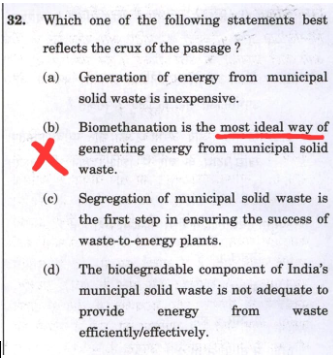
About our Expert: Zeeshan Hashmi, an educator, mentor and UPSC expert, guides aspirants in approaching the civil services exam in a smart way by focusing on strategies which helps in analysing the trends of the exam and strategising the preparation accordingly. In the past, he has provided valuable insights with the UPSC Essentials of The Indian Express on the importance of mentorship.
FYI: The CSAT paper refers to the General Studies Paper-II of the Civil Services (Preliminary) Examination which is a qualifying paper with minimum qualifying marks fixed at 33 per cent. This 200 marks paper comprises questions on comprehension, interpersonal skills including communication skills, logical reasoning, and analytical ability, decision making and problem solving, general mental ability, basic numeracy (numbers and their relations, orders of magnitude, etc.) (Class 10 level), data interpretation (charts, graphs, tables, data sufficiency etc. — Class 10 level). The questions are of multiple choice, objective type.
Approaching Reading Comprehension
Reading Comprehension comprises roughly 27 questions or one-third of the CSAT paper. The other two sections – Quantitative Aptitude and Logical Reasoning – have witnessed increased unpredictability and time-consumption. To overcome this, it is important to attempt the Reading Comprehension section with good accuracy in the minimum time possible.
Let’s discuss a few strategies for objectively approaching the Reading Comprehension section to help you strike this balance.
Broadly, questions in UPSC CSAT’s Reading Comprehension section fall into two main categories – Assumption type and Inference type. Commands like Inference, Implication, Rational message, Crux, Main idea, etc. broadly fall in the latter category.
Story continues below this ad
Difference between Assumption and Inference
Assumption: A given statement is true only if the assumption is true (B is true only if A is true). Inference: Inference is true only if the given statement provides evidence for the inference to be true. (C is true only if B is true).
So, in simplified form, Assumption—Statement—Inference (A—B—C)
Take the example of this statement; “There is rampant corruption in Panchayati Raj Institutions”.
Here a rational assumption would be, “Panchayati Raj Institutions exist at the grassroots level of society” (Because the experience of rampant corruption is premised on the very existence of Panchayati Raj Institutions).
Story continues below this ad
A rational inference, on the other hand, would be, “Poor services are provided to people living in rural areas” (Because of the rampant corruption in the Panchayati Raj Institutions).
Let’s take an example of a passage from the Prelims 2023. It had two questions, one Assumption type, another Inference type:
 UPSC CSE 2023 CSAT Question (image courtesy: Zeeshan Hashmi)
UPSC CSE 2023 CSAT Question (image courtesy: Zeeshan Hashmi)
 UPSC CSE 2023 CSAT Question (image courtesy: Zeeshan Hashmi)
UPSC CSE 2023 CSAT Question (image courtesy: Zeeshan Hashmi)
Statement 1: The passage emphasises that municipal bodies are already hard pressed on budget. So it cannot be rationally assumed from the passage that Government agencies are better placed to handle collection, processing, and segregation of municipal waste. Thus, Statement 1 is incorrect.
Statement 2: The passage emphasises that municipal waste is already mostly handled by the private sector albeit by informally organised units. It further says that the process of waste collection, processing and segregation is full of inefficiencies. So it cannot be rationally assumed from the passage that the private sector enterprises are “best suited” to handle resource recovery and recycling through increased technological inputs.
Story continues below this ad
 UPSC CSE 2023 CSAT Question (image courtesy: Zeeshan Hashmi)
UPSC CSE 2023 CSAT Question (image courtesy: Zeeshan Hashmi)
The passage emphasises that non-segregation of waste is a hindrance to success of waste-to-energy plants. So, it can be rationally inferred from the passage that “segregation of municipal waste is the first step in ensuring the success of waste-to-energy plants”.
Use Common Sense and General Knowledge
Although it sounds counterintuitive, aspirants should use common sense and general knowledge while solving reading comprehension questions. They should not restrict themselves to the explicit information given in the passages. Consider a question from CSAT 2023:
 UPSC CSE 2023 CSAT Question (image courtesy: Zeeshan Hashmi)
UPSC CSE 2023 CSAT Question (image courtesy: Zeeshan Hashmi)
Here, our common sense should guide us to think that if organic farming is indeed inherently unsafe, why is the Government making consistent efforts to integrate it with conventional farming methods?
Avoid Status Quoism and Pessimism
UPSC never frames passages that support status quoism or pessimism. If a given option appears to be status-quoist or pessimistic, it is likely to be incorrect. Take the example of this question asked in CSAT 2023:
Story continues below this ad
 UPSC CSE 2023 CSAT Question (image courtesy: Zeeshan Hashmi)
UPSC CSE 2023 CSAT Question (image courtesy: Zeeshan Hashmi)
The phrase “drug-resistant bacteria cannot be done away with” is not likely to be correct because it has a pessimistic and status quoist tone.
Avoidable Distractions
UPSC provides avoidable distractions in CSAT passages like elaborations, examples, and data. These eat up aspirants’ time in the exam hall, while providing little to no substance to our understanding of the passage. Take the example of this passage and associated question asked in CSAT 2023;
 UPSC CSE 2023 CSAT Question (image courtesy: Zeeshan Hashmi)
UPSC CSE 2023 CSAT Question (image courtesy: Zeeshan Hashmi)
 UPSC CSE 2023 CSAT Question (image courtesy: Zeeshan Hashmi)
UPSC CSE 2023 CSAT Question (image courtesy: Zeeshan Hashmi)
Here even if we ignore the elaboration and data (as highlighted in the passage), the correct answer can be found in the associated question. The passage hints that both nutritional security and environmental sustainability need to be ensured while using nitrogenous fertilisers. Hence it can be rationally implied from the passage that “An enhanced efficiency of use of nitrogen is imperative for both food production and environment”.
Elements of Causality and Intensity
UPSC has the knack of framing incorrect options by adding elements of causality (that show how something causes the assertion to be true). Take an example of this question from CSAT 2023.
Story continues below this ad
 UPSC CSE 2023 CSAT Question (image courtesy: Zeeshan Hashmi)
UPSC CSE 2023 CSAT Question (image courtesy: Zeeshan Hashmi)
Here option (c) provides reasoning as to why drug-resistant bacteria cannot be done away with. Statements giving reasons behind assertions should raise red flags.
UPSC also has the knack of framing incorrect options using expressions that add intensity to a given option. For example, expressions like heavily, totally, entirely, too much, most ideal, etc. add undue weight to given options. For example, take a question asked in CSAT 2023.

Here, option (b) is more likely to be incorrect because of the intensity/extreme tone added by the expression ‘most ideal way of’. The word ‘ideal’ in itself hints at the superior and unique quality of an entity. By adding another superlative (‘most’), the intensity of the option has been artificially increased.
Edited by Ashiya Parveen
Subscribe to our UPSC newsletter and stay updated with the news cues from the past week.
Story continues below this ad
https://www.youtube.com/watch?v=wsnxUastCeM?si=lRUsLaDJYh6RyhH4



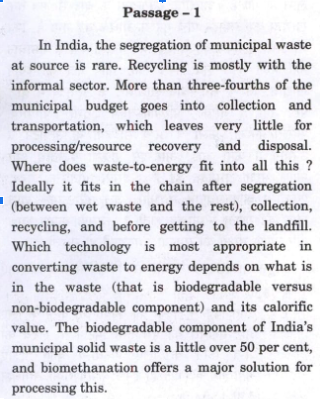 UPSC CSE 2023 CSAT Question (image courtesy: Zeeshan Hashmi)
UPSC CSE 2023 CSAT Question (image courtesy: Zeeshan Hashmi)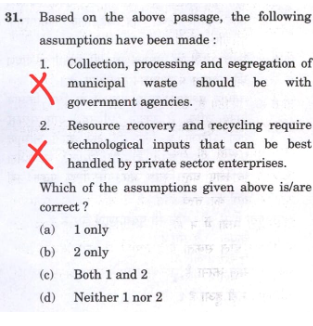 UPSC CSE 2023 CSAT Question (image courtesy: Zeeshan Hashmi)
UPSC CSE 2023 CSAT Question (image courtesy: Zeeshan Hashmi)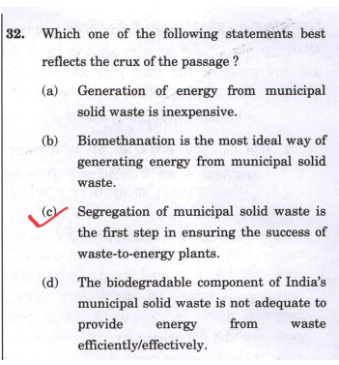 UPSC CSE 2023 CSAT Question (image courtesy: Zeeshan Hashmi)
UPSC CSE 2023 CSAT Question (image courtesy: Zeeshan Hashmi)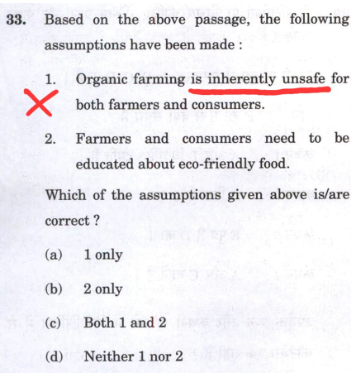 UPSC CSE 2023 CSAT Question (image courtesy: Zeeshan Hashmi)
UPSC CSE 2023 CSAT Question (image courtesy: Zeeshan Hashmi)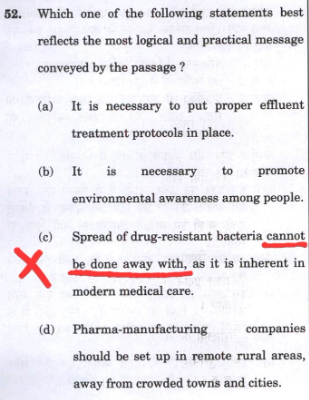 UPSC CSE 2023 CSAT Question (image courtesy: Zeeshan Hashmi)
UPSC CSE 2023 CSAT Question (image courtesy: Zeeshan Hashmi)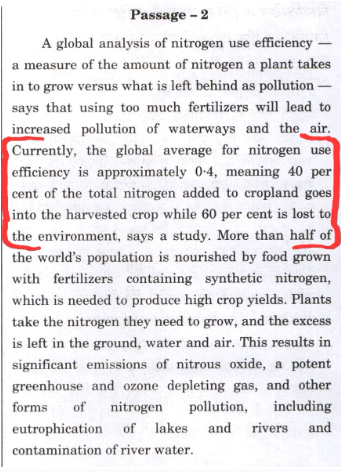 UPSC CSE 2023 CSAT Question (image courtesy: Zeeshan Hashmi)
UPSC CSE 2023 CSAT Question (image courtesy: Zeeshan Hashmi)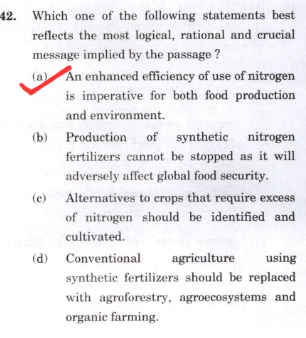 UPSC CSE 2023 CSAT Question (image courtesy: Zeeshan Hashmi)
UPSC CSE 2023 CSAT Question (image courtesy: Zeeshan Hashmi)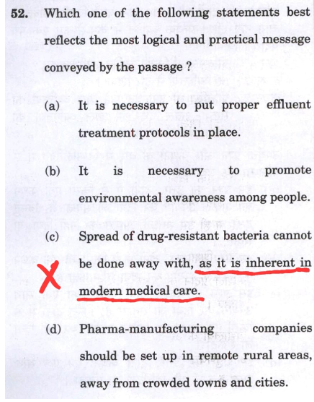 UPSC CSE 2023 CSAT Question (image courtesy: Zeeshan Hashmi)
UPSC CSE 2023 CSAT Question (image courtesy: Zeeshan Hashmi)